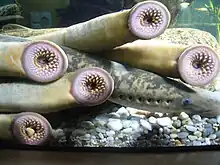Cyclostomata
Translingual
Etymology
From French cyclostome, from Ancient Greek κύκλος (kúklos, “circle”) + στόμα (stóma, “mouth”).
Proper noun
Cyclostomata
- A taxonomic class within the subphylum Vertebrata – the living jawless fishes: lampreys and hagfishes; the cyclostomes.
- 1834, Peter Mark Roget, Animal and Vegetable Physiology, volume 2 (in English), William Pickering, page 116:
- Among fishes, we meet with the family of Cyclostomata, so called from their having a circular mouth, formed for suction.
- 2009, Shigehiro Kuraku et al., “Jawless Fishes (Cyclostomata)”, in The Timetree of Life (in English), Oxford University Press, page 317:
- Cyclostomata comprises two families of living jawless fishes: hagfishs (Myxinidae, 44 species) and lampreys (Petrymyzonidae, 41 species).
- A taxonomic order within the phylum Bryozoa – the Cyclostomatida.[1]
Synonyms
- (order): Cyclostomatida
Hypernyms
- (class): Eukaryota – superkingdom; Animalia – kingdom; Bilateria – subkingdom; Deuterostomia – infrakingdom; Chordata – phylum; Vertebrata - subphylum; Agnatha - infraphylum
- (order): Eukaryota - superkingdom; Animalia - kingdom; Bilateria - subkingdom; Protostomia - infrakingdom; Spiralia - superphylum; Bryozoa - phylum; Stenolaemata - class[1]
Hyponyms
- (class): Myxiniformes (hagfishes), Petromyzontiformes (lampreys) - orders
- (order): Articulata, Cancellata, Cerioporina, Fasciculina, Rectangulata, Tubuliporina - suborder[1]
Coordinate terms
- (class): Gnathostomata
References
- class of Vertebrata
 Cyclostomata on Wikipedia.Wikipedia
Cyclostomata on Wikipedia.Wikipedia  Cyclostomata on Wikispecies.Wikispecies
Cyclostomata on Wikispecies.Wikispecies  Category:Cyclostomata on Wikimedia Commons.Wikimedia Commons
Category:Cyclostomata on Wikimedia Commons.Wikimedia Commons
- order of Bryozoa
 Cyclostomatida on Wikipedia.Wikipedia
Cyclostomatida on Wikipedia.Wikipedia  Cyclostomatida on Wikispecies.Wikispecies
Cyclostomatida on Wikispecies.Wikispecies  Category:Cyclostomatida on Wikimedia Commons.Wikimedia Commons
Category:Cyclostomatida on Wikimedia Commons.Wikimedia Commons - Cyclostomata at World Register of Marine Species
- Ruggiero MA, Gordon DP, Orrell TM, Bailly N, Bourgoin T, Brusca RC, et al. (2015) A Higher Level Classification of All Living Organisms. PLoS ONE 10(4): e0119248. PMID 25923521, doi: 10.1371/journal.pone.0119248
This article is issued from Wiktionary. The text is licensed under Creative Commons - Attribution - Sharealike. Additional terms may apply for the media files.
